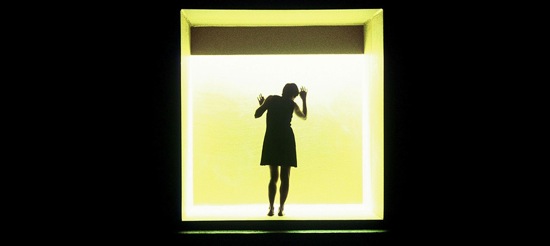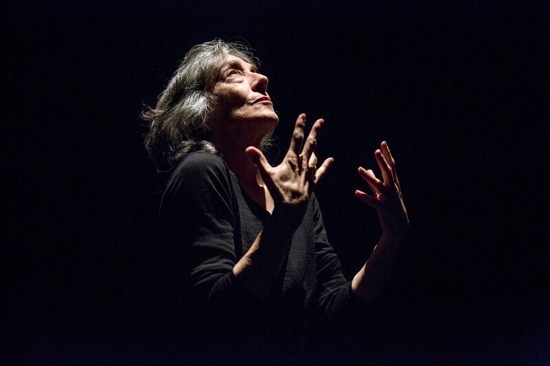Helen Herbertson and Ben Cobham bring their Morphia Series to the Coil Festival.

Helen Herbertson in Morphia Series. Photo: Rachelle Roberts
Sometimes what surrounds a performance affects your experience of it. My experience of Helen Herbertson and Ben Cobham’s Morphia Series included the journey to and from it—in terms of both mind and body. And then a fruitless online trip to access an essay about it: Loadingloadingloadingloading. . . .
Herbertson is a distinguished, Melbourne-based Australian choreographer, and her appearance here with her co-creator, Ben Cobham, is part of the cauldron of dance that New York has become during the period of the COIL 2016 Festival and the annual conference of the Association of Producers and Presenters (APAP). Someone could be dancing on your window sill. Look out!
Morphia Series is being presented January 12 through 16 by Performance Space 122 and Baryshnikov Arts Center as part of the COIL 2016 Festival. It’s to the latter space that I make my way through midtown’s steel and granite canyons, where chill breezes gather. A subway and a bus still leave me with a two-and-a-half block’s walk along West 37th Street. I’m early because I’m afraid I might be late, and I’ve been warned: only twelve people at a time can see this show. So I sit or stand in the dimly lit fourth floor lobby with a handful of others for quite a while. That’s where I learn that the performance lasts twenty minutes.
It’s pitch black in the huge studio; we’re guided in two at a time by people with flashlights, stopping on the way to pick up a shot glass of wine and a tiny square of bread with stuff piled up on it. (We were told the ingredients of these “morsels” created by John Salisbury, but all I can recall are mascarpone and a raspberry.) I now think the purpose of the offering was to help us prepare for miniaturization. Morphia Series has been characterized as “a set of visual haikus, inspired by Morpheus, son of Hypnos and the god of dreams.”
What we see are three liminal moments, like those that occur between waking and dreaming, between the everyday and the metaphysical. The program also alerts us to smallness with a quote by Anne Michaels:“The memories we elude catch up to us, overtake us like a shadow, a truth appears suddenly in the middle of a thought, a hair on a lens.”
A woman’s quiet recorded voice speaks in the darkness. I can make out some words: “dream,” “cold and frozen landscape.” The first image is of a nearly square box, about nine feet tall and set on end; it’s some distance away from us, and two white lines, like the edging of a road, lead to it.
The box is beautiful. Cobham’s lighting fills it with a golden glow and deeper-toned swirling clouds, against which Herbertson is silhouetted—a narrow vertical shape, with its back to us. Swirls of mist escape the box and gird her hips.
She moves very minimally. One hand crooks up at the wrist and moves a few inches away from her side; then it disappears in front of her. The other hand moves to a horizontal place, the hand resembling an open mouth. (Does the rumbling I hear come from the street?) Herbertson walks in profile, busy with her arms; they flourish, seem to weigh or toss things, yet are mostly stiff. Like ice? Small, explosive sounds cause her to freeze momentarily. Or is it the reverse? Blackout.

Helen Herbertson in Morphia Series by Herbertson and Ben Cobham. Photo Maria Baranova
The light in Herbertson’s box reappears—dimmer and reddish in color. The sounds are of water. Herbertson wears a short dress, and, at first, we can just make her out as she bends and sways and leans and hunches her shoulders. She seems to cringe, but ends in a corner looking up. Are these the words I hear—“she wanted to see the light change” and “to stand in a storm protected by glass?” Blackout.
The third section begins with a deep burbling sound and flashing lights. There are no clouds in the box now, just a wash of amber. Herbertson, naked, stands at its brink facing us. Suddenly, we hear what sound like heavy footsteps or bumping around. Are a couple of people leaving? The noise level increases. I feel the floor vibrate under my feet and resonate in my gut. But it’s not the sound that’s doing it. How to convey the terror when the box containing Herbertson rushes toward us? But, no, we’re the ones being rushed toward her.
I’m inches from her when she begins to scrub her hands, as if getting rid of the sand that the voice mentions (“The imprint of a strong hand,/a boot, in the sand/jumbled. . .”). She bends down, sways from side to side. Her last move is to gasp, twist, and flinch away. Blackout, and the platform on which we sit rolls back to its original spot. In the darkness, someone tentatively pats his/her hands together, and the flashlight people come to guide us out.
I think of Basho’s famous haiku (as translated by Alan Watts). “The old pond/ A frog jumps in:/ Plop!”
I’d have preferred “Splash!” It’s more like the sudden taste in the mouth that no tiny sips and nibbles could provide. Fear, amazement, frustration, and something like exhilaration.
Then the cold walk through the dark city streets, a moment of warmth provided by a not-quite-stranger’s words, and lo! A train rumbling into the station the minute my feet touch the last stair.
And I ponder. A frail, sharp-edged gleam on a vast black velvet surface?

This post scared the bejesus out of me Deborah; you not only put me in the audience with you, you made me damned glad I wasn’t actually there, even though you found great beauty in the piece’s imagery. Lovely writing, I must say.